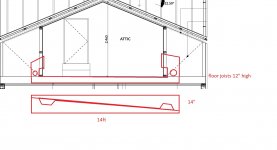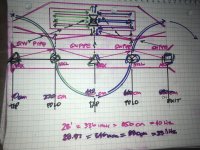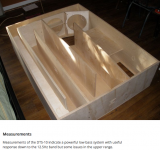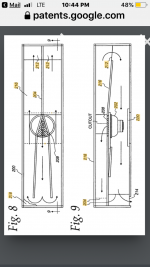I'm currently building a new house,i have everything for the theater except the subs.Iv'e read heaps of threads and changed direction on which way to go several times!
I want the theater to be clean and free on clutter as possible as it will double as a guest room occasionally and i have the space to conceal subs within the floor/walls (the rest of the speakers will be in walls)
after reading the following threads and the comments about impressive outputs from smaller drivers i decided a small sub in a horn could be the way to go
AVS Forum
Reed Exodus Anarchy 25hz Tapped Horn
Well here it is..Exodus Anarchy 6.5" 25hz tapped horn designed by yours truly, LilMike. Much appreciation to lilmike for sliding me the plans and letting me build it early before he measured it and made them available. I Got the pleasure of hanging with lilmike and getting this sub measured...
AVS Forum AVS Forum
Home Theater Forum and Systems
My First DIY Horn Subwoofer
Introduction.. Well actually it's my first ever DIY subwoofer!.. Even though I've been involved in HT for over 30 years and have built many different speakers in that time, I've never built a sub. before! I just recently finished building 3 horn speakers for my fronts (based on the original...
Home Theater Forum and Systems Home Theater Forum and Systems
i then came across this thread and an idea started to form
AVS Forum
The Crawler, A Floor joist horn build
I hate crawl spaces myself. But physicked myself up for this one because of the benefit, So stealth, accurate bass and hopefully a memorable couch ride or two. Got to beat a harley. I think it was way easier on my back than a sealed box would have been. Heaviest part of this one was the motor...
AVS Forum AVS Forum
now, i've never built speakers before but i am a carpenter so the construction of the boxes would be no problem what i would like to know is if the sketch below has any merit?should i continue to pursue the idea?
hopefully there's enough info there to get my idea across(its probably clear why i'm a carpenter and not a graphic designer though!)
I want the theater to be clean and free on clutter as possible as it will double as a guest room occasionally and i have the space to conceal subs within the floor/walls (the rest of the speakers will be in walls)
after reading the following threads and the comments about impressive outputs from smaller drivers i decided a small sub in a horn could be the way to go
AVS Forum
Reed Exodus Anarchy 25hz Tapped Horn
Well here it is..Exodus Anarchy 6.5" 25hz tapped horn designed by yours truly, LilMike. Much appreciation to lilmike for sliding me the plans and letting me build it early before he measured it and made them available. I Got the pleasure of hanging with lilmike and getting this sub measured...
AVS Forum AVS Forum
Home Theater Forum and Systems
My First DIY Horn Subwoofer
Introduction.. Well actually it's my first ever DIY subwoofer!.. Even though I've been involved in HT for over 30 years and have built many different speakers in that time, I've never built a sub. before! I just recently finished building 3 horn speakers for my fronts (based on the original...
Home Theater Forum and Systems Home Theater Forum and Systems
i then came across this thread and an idea started to form
AVS Forum
The Crawler, A Floor joist horn build
I hate crawl spaces myself. But physicked myself up for this one because of the benefit, So stealth, accurate bass and hopefully a memorable couch ride or two. Got to beat a harley. I think it was way easier on my back than a sealed box would have been. Heaviest part of this one was the motor...
AVS Forum AVS Forum
now, i've never built speakers before but i am a carpenter so the construction of the boxes would be no problem what i would like to know is if the sketch below has any merit?should i continue to pursue the idea?
hopefully there's enough info there to get my idea across(its probably clear why i'm a carpenter and not a graphic designer though!)
Attachments
well,it potentially could be but i'm a bit out of my depth with hornresp etc being a beginner and all.
do you think its doable? worth persuing?
do you think its doable? worth persuing?
100% yes! And gladly help sim it if you need. i have a folded version of similar but this is really cool and a rare treat as (Ive never gone much more than 9 feet straight.) not often is there room For this. but my floor is similar with lots of crawl space...
i'd imagine more people have space for something like than realise they do,once the house is built the idea however the of tearing it apart for a speaker is a bit unpalatableand it is kind of permanent!
your help on this would be awesome as i'm currently thinking i'm a bit over my head with this stuff!
my maiin goal is to get as low as possible,huge volume isn't an issue-i have neighbours 🙁 and size is what it is. i guess driver size is limited to 10" due to depth constraints unless there's a more suitable orientation?
i'm several months from being able to implement anything as i'm only just standing frames!
your help on this would be awesome as i'm currently thinking i'm a bit over my head with this stuff!
my maiin goal is to get as low as possible,huge volume isn't an issue-i have neighbours 🙁 and size is what it is. i guess driver size is limited to 10" due to depth constraints unless there's a more suitable orientation?
i'm several months from being able to implement anything as i'm only just standing frames!
If your floor joists are 16" on center, 12" drivers would fit easily, if oriented horizontally.
Diagonally, 15" drivers would fit. Multiple 10" drivers could be placed vertically, avoiding long term cone sag issues, which would be a problem for most very low Fs drivers appropriate for VLF reproduction.
Considering the build complexity and material used, might as well use 4 drivers.
A single fold of 14' results in a 28' path length.
The low excursion minima frequency in a tapped horn is 1/4 wavelength.
1130 (speed of sound in feet per second) divided by 28 = 40.3 divided by 4=10Hz.
With the extra length up and down to the mouth exits, solid 10 Hz response should be no problem, though what the in room response will be with the fixed locations is another issue entirely. That said, TH response is limited to a couple octaves of smooth response, so your main speakers would need to come in around 40 Hz.
If you know of a house with a similar attic space, some testing there would be very helpful before committing to a joist location- moving the sub a few feet to a better spot won't be possible after construction ;^)
Diagonally, 15" drivers would fit. Multiple 10" drivers could be placed vertically, avoiding long term cone sag issues, which would be a problem for most very low Fs drivers appropriate for VLF reproduction.
Considering the build complexity and material used, might as well use 4 drivers.
A single fold of 14' results in a 28' path length.
The low excursion minima frequency in a tapped horn is 1/4 wavelength.
1130 (speed of sound in feet per second) divided by 28 = 40.3 divided by 4=10Hz.
With the extra length up and down to the mouth exits, solid 10 Hz response should be no problem, though what the in room response will be with the fixed locations is another issue entirely. That said, TH response is limited to a couple octaves of smooth response, so your main speakers would need to come in around 40 Hz.
If you know of a house with a similar attic space, some testing there would be very helpful before committing to a joist location- moving the sub a few feet to a better spot won't be possible after construction ;^)
Last edited:
What if you place the driver(s) at midpoint and start of the pipe(s). Fold both of those halves and create two qw pipes as one halfwave tapped pipe which all together in series makes the sine wave and breaks at nulls? Im only at 39 hz but wow is it loud with the drivers ive got(12 “ pair acts like a single 18ds115 if damped a bit by a lesser CSA. 14.5” spacing fits the basket mount flange.
breaking from this idea into lower Hz. I see a tower of power as 17 hz and its driver throat tap/80cm/fold/160 cm/fold/80cm/driver tap / 80’cm /exit or the 75/150 version of that.
the small CSA helps here with a bunch of motorforce, Bl^2/Re is 28^2/3.9, but these things wont go below 30 until we let up on the juice. (Easy, i was at xmax with 68 volts into DCRe. 20 hz is there, in a liwer power input for HT? but i dont think i can say beyond, as anymore is uncharted territory for me🙂 maybe its dayton audio rss 315 for the low Fs?
breaking from this idea into lower Hz. I see a tower of power as 17 hz and its driver throat tap/80cm/fold/160 cm/fold/80cm/driver tap / 80’cm /exit or the 75/150 version of that.
the small CSA helps here with a bunch of motorforce, Bl^2/Re is 28^2/3.9, but these things wont go below 30 until we let up on the juice. (Easy, i was at xmax with 68 volts into DCRe. 20 hz is there, in a liwer power input for HT? but i dont think i can say beyond, as anymore is uncharted territory for me🙂 maybe its dayton audio rss 315 for the low Fs?
Attachments
Last edited:
If your floor joists are 16" on center, 12" drivers would fit easily, if oriented horizontally.
Diagonally, 15" drivers would fit. Multiple 10" drivers could be placed vertically, avoiding long term cone sag issues, which would be a problem for most very low Fs drivers appropriate for VLF reproduction.
Considering the build complexity and material used, might as well use 4 drivers.
A single fold of 14' results in a 28' path length.
The low excursion minima frequency in a tapped horn is 1/4 wavelength.
1130 (speed of sound in feet per second) divided by 28 = 40.3 divided by 4=10Hz.
With the extra length up and down to the mouth exits, solid 10 Hz response should be no problem, though what the in room response will be with the fixed locations is another issue entirely. That said, TH response is limited to a couple octaves of smooth response, so your main speakers would need to come in around 40 Hz.
If you know of a house with a similar attic space, some testing there would be very helpful before committing to a joist location- moving the sub a few feet to a better spot won't be possible after construction ;^)
the room is rectangular and approximately 13.5 by 20 ft with the ceiling shape as shown in the first post.the seating position will be about 13 ft back from the screen (130") at this stage i'm going to set up for 7 surround channels and prewire for overhead atmos.
in my mind the mouths of the horns would be roughly central in the room , but can be anywhere if its possible to predict where the best location may be beforehand?
at worst it would be a waste of time and a few sheets of mdf-i can always remove the drivers and leave the box in place.
Actually whilst typing that i was thinking-if it was in place before i construct the garage ceiling it could always be dropped out and relocated to another spot...hmm
as for my mains going down to 40hz-i'd have to check how they'd perform,when i said low i never anticipated a suggestion of a solid 10hz! that'd be awesome-the neighbours will love it🙂
What if you place the driver(s) at midpoint and start of the pipe(s). Fold both of those halves and create two qw pipes as one halfwave tapped pipe which all together in series makes the sine wave and breaks at nulls? Im only at 39 hz but wow is it loud with the drivers ive got(12 “ pair acts like a single 18ds115 if damped a bit by a lesser CSA. 14.5” spacing fits the basket mount flange.
breaking from this idea into lower Hz. I see a tower of power as 17 hz and its driver throat tap/80cm/fold/160 cm/fold/80cm/driver tap / 80’cm /exit or the 75/150 version of that.
the small CSA helps here with a bunch of motorforce, Bl^2/Re is 28^2/3.9, but these things wont go below 30 until we let up on the juice. (Easy, i was at xmax with 68 volts into DCRe. 20 hz is there, in a liwer power input for HT? but i dont think i can say beyond, as anymore is uncharted territory for me maybe its dayton audio rss 315 for the low Fs?
i won't pretend to understand all of that-i'm still reading up on some of the terms but the bits i follow sound awesome. i'll do a bit more googling and when i understand a bit more i'll add more comments 😀
Last edited:
The DSL DTS-10 is a proven 2x12" tapped horn design that comes close to your dimensions, you could use the floor joists as sidewalls, as the outer dimension of the DTS-10 is 16", and it's 23.5 cubic foot (exterior) volume is about the same as the space between joists you are considering:
Data-Bass: Subwoofer Measurements
As a very rough estimate, the (unfolded) path length appears around 23 feet, though the 14.3Hz impedance minima (also the lowest excursion minima) would indicate about 19.75 feet effective path length.
Art
Data-Bass: Subwoofer Measurements
As a very rough estimate, the (unfolded) path length appears around 23 feet, though the 14.3Hz impedance minima (also the lowest excursion minima) would indicate about 19.75 feet effective path length.
Art
Attachments
The DSL DTS-10 is a proven 2x12" tapped horn design that comes close to your dimensions, you could use the floor joists as sidewalls, as the outer dimension of the DTS-10 is 16", and it's 23.5 cubic foot (exterior) volume is about the same as the space between joists you are considering:
Data-Bass: Subwoofer Measurements
As a very rough estimate, the (unfolded) path length appears around 23 feet, though the 14.3Hz impedance minima (also the lowest excursion minima) would indicate about 19.75 feet effective path length.
Art
Ironically it is related to so many things? Theres a secret sauce here. I wish i knew how to describe it.
The peaks that require EQ to be usefull in these designs are also the reason they can be used. the folding is still off be one segmental length in the harmonics. i think its a bit harder to do than just that, but its easy to see the affect in other well known designs all over
Attachments
Last edited:
- Home
- Loudspeakers
- Subwoofers
- dual 8" subfloor tapped horn



